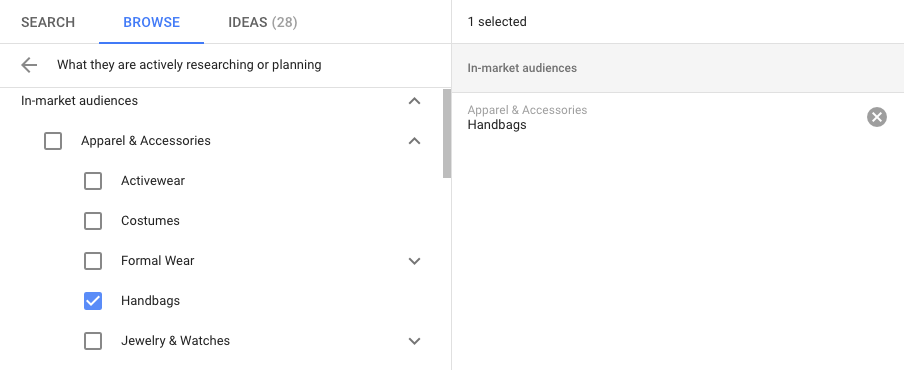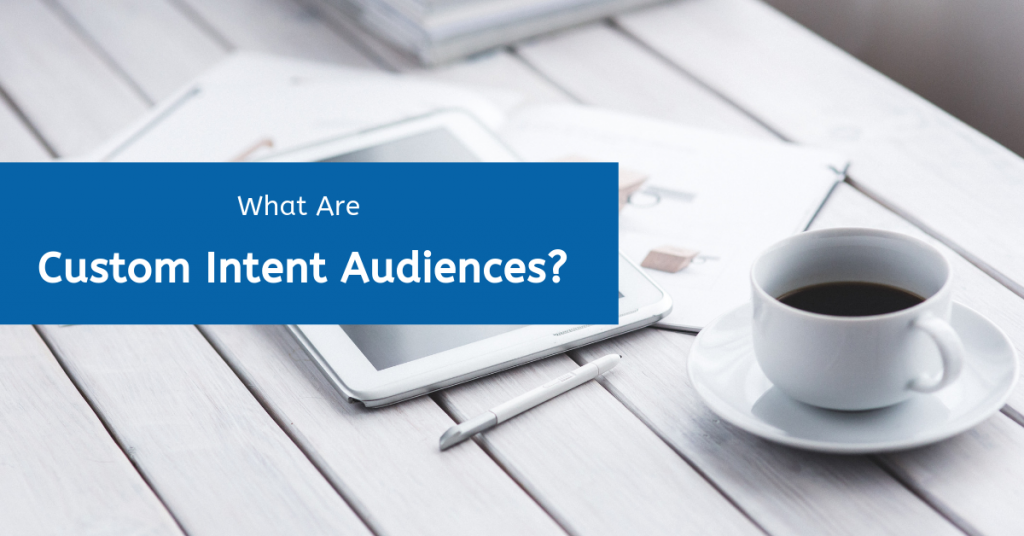Update: As of Fall 2020, custom intent audiences have been replaced by custom audiences in Google Ads.
Custom intent audiences are a new targeting tool for PPC campaigns in Google Ads. Custom intent is the most granular audience targeting method available, helping advertisers target people who are already on the buying journey.
PPC marketers build these lists by entering specific URLs, keywords, and/or apps into a list. Google identifies users who have visited those websites, searched for those keywords, or used those apps. Those users will then see your ad throughout the Google Display Network or YouTube.
How is this different than other audience targeting?
Custom Intent vs. Affinity Audiences
Custom intent audiences are different than affinity audiences because the targeting focuses on intent, not interest.
Affinity audiences are great for building brand awareness and expanding your reach, but not necessarily for driving conversions. Custom intent audiences, however, identify and focus on users who are ready to make a purchase relevant to your business.
Custom Intent vs. In-Market Audiences
These two audience targeting methods are very similar, as both try to identify users with purchasing intent. However, custom intent audiences are more targeted than in-market.
When creating in-market audiences, advertisers must choose from a pre-populated list of topics. Google then identifies users whose browser behavior indicates they’re considering a purchase within that category. This is great for targeting mid-funnel consumers.
However, because the in-market topics are fairly generic, you may end up targeting people who do not fit your intended audience. This can result in wasted media spend.
Custom intent audiences get more granular, as to actually select specific websites that a user has visited and keywords they’ve searched. This allows advertisers to take their targeting a step further and hone in on lower-funnel consumers.
For example, say you sell high-end, designer handbags. Using an in-market audience, you can target someone who is looking to purchase a handbag.

However, that is still somewhat general. Since your company sells high-end handbags, you don’t want to target a user looking for discounted or knock-off handbags. Chances are, if that user clicked your ad, went to your site, and saw your prices, he or she would not end up converting. In a PPC campaign, that results in wasted media spend.
On the other hand, by using a custom intent audience, you could input URLs of competitors with similar prices and target users who have shopped on those sites. Plus, you can input more specific, long-tail keywords like high-end handbags, genuine designer handbags, luxury handbags, and more to make sure you appeal to exactly the right consumers.
How do I create custom intent audiences?
Just as with the other audience targeting methods in Google Ads, you create custom intent audiences through the Audiences tab. There are two options for generating the audience list.
The first option is the automated approach. With this option, Google uses artificial intelligence (AI) to build the audience. With the manual option, you hand-pick the keywords, URLs, and apps used to build your audience.
To be clear, the URLs and apps you choose don’t mean that your ads will show up on those websites or apps. Instead, Google shows your ad throughout the Display Network, or on YouTube (more on that below), to users who have accessed the URLs and apps you identify.
Can I apply custom intent audiences to any campaign?
Custom intent audiences are currently available for display and YouTube campaigns. The guidelines are slightly different for the two ad formats when it comes to developing the audience.
Advertisers can only use keywords, not URLs or apps, to build custom intent audiences for YouTube. Google recommends adding at least 50 keywords for each audience.
To create custom intent audiences for display ads, you can input keywords, URLs, and apps. For best results, avoid general, low-intent keywords, and keep your audience focused around a particular product or service offering.
Summary: Why should I use custom intent audiences?
1. To reach your target audience when they’re ready to make a purchase
Because you are able to target users who open certain apps, visit specific URLs, and search for long-tail keywords, you can target users who have buying intent related to your products or services. This allows you to reach the right consumers at the right time.
2. To reduce wasted media spend
Targeting broad groups of people who may or may not be interested in buying from your business often results in paying for unqualified clicks. By showing your ad to a very targeted group of people who’ve demonstrated intent to purchase a product or service that your business sells, you should only spend money on clicks with the potential to convert.
3. To improve your campaign metrics
Although your overall click volume may decrease, the clicks you receive will be more qualified. This means that you’ll likely see your clickthrough rate (CTR) and conversions increase, and your cost per acquisition (CPA) decrease. When your PPC goal is to drive conversions, these are indicators of an effective campaign.
Want to learn more about custom intent audiences? Creative Website Marketing has had success using this new tool, and we’d love to help your business utilize it as well. Contact us for more information, or view our PPC Management services.
Creative Website Marketing is a digital marketing agency in Nashville, TN, helping businesses throughout the country execute strategic brand awareness + lead generation efforts.

